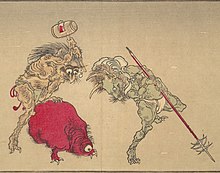Yokai

Yōkai (妖怪 literally demon, spirit, or monster) are a class of preternatural creatures in Japanese folklore ranging from the evil oni (ogre) to the mischievous kitsune (fox) or snow woman Yuki-onna. Some possess part animal and part human features (e.g. Kappa and Tengu). Yōkai generally have a sort of spiritual or supernatural power. Yōkai that have the ability to shape-shift are called obake.
Japanese folklorists and historians use yōkai as "supernatural or unaccountable phenomena to their informants". In the Edo period, many artists, such as Toriyama Sekien, created a lot of yōkai inspired by folklore or their own ideas, and in the present, not a few yōkai created by them (e.g. Kameosa and Amikiri, see below) are wrongly considered as being of legendary origin.
From the 1960s on, manga artist Shigeru Mizuki popularized many types of yōkai in his works (e.g., the titular one-eyed yōkai protagonist in Ge Ge Ge no Kitaro). Lafcadio Hearn's collection of Japanese ghost stories entitled Kwaidan: Stories and Studies of Strange Things includes stories of yūrei and yōkai such as Yuki-onna.
Types
There are a wide variety of yōkai in Japanese folklore. In general, yōkai is a broad term, and can be used to encompass virtually all monsters and supernatural beings, even including creatures from European folklore on occasion (e.g., the English bugbear is often included in Japanese folklore to the point that some mistakenly believe it originates from said folklore).


Shapeshifting animals
A good number of animals that are thought to have magic of their own can be found in Japan. Most of these are henge (変化), shapeshifters, which often imitate humans, mostly women. Some of the better known animal yōkai include the following:
- Tanuki (raccoon dog)
- Kitsune (foxes)
- Hebi (snakes)
- Mujina (badgers)
- Bakeneko (cats)
- Ōkami (wolves)
- Tsuchigumo and jorōgumo (spiders)
- Inugami (dogs)
Oni
One of the most well-known aspects of Japanese folklore is the oni, which is a sort of mountain-dwelling ogre, usually depicted with red, blue, brown or black skin, two horns on its head, a wide mouth filled with fangs, and wearing nothing but a tigerskin loincloth. It often carries an iron club or a giant sword. Oni are mostly depicted as evil, but can occasionally be the embodiment of an ambivalent natural force. They are, like many obake, associated with the direction northeast.
Tsukumogami
Tsukumogami are an entire class of yōkai and obake, comprising ordinary household items that have come to life on the one-hundredth anniversary of their birthday. This virtually unlimited classification includes Bakezouri (straw sandals), Karakasa (old umbrellas), Kameosa (old sake jars), and Morinji-no-kama (tea kettles).
Human transformations
There are a large number of yōkai which were originally ordinary human beings, transformed into something horrific and grotesque usually by some sort of extreme emotional state. Women suffering from intense jealousy, for example, were thought to transform into the female oni represented by hannya masks. Other examples of human transformations or humanoid yōkai are the rokuro-kubi (humans able to elongate their necks during the night), the ohaguro-bettari (a figure, usually female, that turns to reveal a face with only a blackened mouth), futakuchi-onna (a woman with a voracious extra mouth on the back of her head), and dorotabō (the risen corpse of a farmer, who haunts his abused land), among many others.
In popular culture
Various kinds of yōkai are encountered in folklore and folklore-inspired art and literature, particularly manga and Japanese horror. Shigeru Mizuki, the manga creator of such series as GeGeGe no Kitaro and Kappa no Sanpei, keeps yōkai in the popular imagination, at least in Japan. With the exception of three volumes of GeGeGe no Kitaro, however, Mizuki's works have yet to be translated into English.
Yōkai have continued to be a common theme in modern works of fiction. They served as the stars in the 1960s Yokai Monsters film series, which was loosely remade in 2005 as Takashi Miike's The Great Yokai War. They often play major roles in Japanese animation and comics, including animated films such as Studio Ghibli's Pom Poko, and various series such as InuYasha, Jigoku Shoujo, Rosario+Vampire, Kanokon, Yōkai Ningen Bem, Hell Teacher Nūbē, Karas, Tactics, Tsubasa Reservoir Chronicle, YuYu Hakusho, Saiyuki, Kekkaishi, Nurarihyon no Mago, Shonen Onmyouji, Natsume Yuujinchou, Yozakura Quartet, Amatsuki, Otome Yōkai Zakuro and xxxHolic. They also appear commonly in video games, such as Darkstalkers, Ōkami, Touhou, Harukanaru Toki no Naka De and Pocky & Rocky, as well as tokusatsu series like Ninja Sentai Kakuranger, Samurai Sentai Shinkenger and Kamen Rider Hibiki
Some of these sources, including Inuyasha, feature the child of a yōkai and a human. This child is referred to as a 'hanyou' or 'hanyō,' in Inuyasha. This may derive from folkloric tradition - some folklore also deals with the child of a yōkai and a human, which may have supernatural powers.
Foreign works
In the English-speaking world, knowledge of yōkai is slowly, but surely, developing a dedicated following. Hawaiian folklorist Glen Grant was known for his "Obake Files", a series of reports he developed about supernatural incidents in Hawaii; the grand bulk of these incidents and reports were of Japanese origin, though in retelling have been much modified from their original forms in Japanese folklore. Another cultural reference is in the Oriental Adventures Dungeons and Dragons rulebook where one of the playable races is the hengeyokai, shapeshifters that can assume a human form, an animal form, and a hybrid bipedal animalistic form.
As a location
In more modern works, yōkai (妖界, note the different kanji) and makai (魔界) are used synonymously as the supernatural world where yōkai live. Works which have included one or the other include the manga series Tokimeki Tonight and the young adult fiction series Yōkai Navi Luna (妖界ナビ・ルナ).
![[J-BLOG] Map, Culture & Traditional, Etc.](https://blogger.googleusercontent.com/img/b/R29vZ2xl/AVvXsEhvmfEXojE4IaQHEj7WJFFqXpc3QG9Ha9bRblYtkTG45gtZEvAQVzCYNBMEk9AZt7shLWsSI-b7qM1JKgtTeaxkQC4cI557LmRMY40UOkXKjybg3WIIVXCrwdfnFlpWjha0CFeeTp9DPSk/s1600-r/j-blog_banner.png)
No comments:
Post a Comment